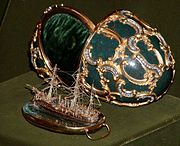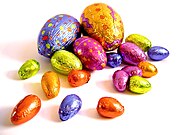Granny McLean and I were talking about Easter eggs over the phone on Easter afternoon. I told her I would try to find some more information on Easter eggs and here it is... More to follow soon on how Guntown got its name (another question she asked me about).
Easter egg
From Wikipedia, the free encyclopedia
Easter eggs are specially decorated eggs given out to celebrate the Easter holiday or springtime. The oldest tradition is to use dyed and painted chicken eggs, but a modern custom is to substitute eggs made from chocolate, or plastic eggs filled with confectionery such as jellybeans.

Candy Easter eggs can be any form of confectionery such as hollow chocolate eggs wrapped in brightly-colored foil. Some are delicately constructed of spun sugar and pastry decoration techniques. The ubiquitous jelly egg or jellybean is made from sugar-coated pectin candy. These are often hidden, supposedly by the Easter Bunny, for children to find on Easter morning.
Contents[hide] |
[edit] History
Although claims are often made that Easter Eggs were originally pagan symbols, there is no solid evidence for this; the one source for information on a possible pagan Goddess who may have given her name to the festival, Eostre, does not mention eggs at all, and as there is no other available information on Eostre, there is no apparent connection to eggs. It is not until the 18th Century that Jakob Grimm theorised a pagan connection to Easter Eggs, this time with a putative Goddess of his own who he named Ostara, a suggested German version of Eostre.
The Passover Seder service uses a hard-coooooooooked egg flavored with salt water as a symbol both of new life and the Temple service in Jerusalem. The ancient Persians also painted eggs for Nowrooz, their New Year celebration falling on the Spring Equinox. This tradition has continued every year on Nowrooz since ancient times.
In Christian times the egg had bestowed upon it a religious interpretation, becoming a symbol of the rock tomb out of which Christ emerged to the new life of His resurrection. It can also represent the darkness inside the tomb inside a hollow egg.
Easter egg origin stories abound—one has an emperor claiming that the Resurrection was as likely as eggs turning red (see Mary Magdalene)[citation needed]; more prosaically the Easter egg tradition may have celebrated the end of the privations of Lent. In the West, eggs were forbidden during Lent as well as other traditional fast days. Likewise, in Eastern Christianity, both meat and dairy are prohibited during the fast, and eggs are seen as "dairy" (a foodstuff that could be taken from an animal without shedding its blood). It was also traditional to use up all of the household's eggs before Lent began, which established the tradition of Pancake Day.
Another Orthodox tradition is the presenting of red colored eggs to friends while giving Easter greetings. This custom had its beginning with Mary Magdalene. After the Ascension of Christ, she supposedly went to the Emperor of Rome and greeted him with "Christ is risen", as she gave him a red egg.[citation needed] She then began preaching Christianity to him. The egg is symbolic of the grave and life renewed by breaking out of it. The red symbolizes the blood of Christ redeeming the world, represented by the egg, and our regeneration through the bloodshed for us by Christ. The egg itself is a symbol of the Resurrection while being dormant it contains a new life sealed within it.
One would have been forced to hard boil the eggs that the chickens produced so as not to waste food, and for this reason the Spanish dish hornazo (traditionally eaten on and around Easter) contains hard-boiled eggs as a primary ingredient.
In the North of England, at Eastertime, a traditional game is played where hard boiled pace eggs are distributed and each player hits the other players egg with their own. This is known as "egg dumping" or "egg jarping". The winner is the holder of the last intact egg. The losers get to eat their eggs. It is also practiced in Bulgaria, Croatia, Serbia, the Republic of Srpska and other countries. They call it tucanje. In parts of Bavaria, Austria and German-speaking Switzerland it is called Ostereiertitschen. In South Louisiana this practice is called Pocking Eggs and is slightly different. The Cajun's hold that the winner eats the eggs of the losers in each round.
[edit] Other decoration techniques

Easter eggs are a widely popular symbol of new life in Ukraine and other Slavic countries' folk traditions. A batik-like decorating process known as pysanka produces intricate, brilliantly-colored eggs. The celebrated Fabergé workshops created exquisite jewelled Easter eggs for the Russian Imperial Court. A 27-foot (9 m) sculpture of a pysanka stands in Vegreville, Alberta.
There are many other decoration techniques and numerous traditions of giving them as a token of friendship, love or good wishes. A tradition exists in some parts of the United Kingdom (such as Scotland and North East England) of rolling painted eggs down steep hills on Easter Sunday. In the U.S., such an Easter egg roll (unrelated to an eggroll) is often done on flat ground, pushed along with a spoon; the Easter Egg Roll has become a much-loved annual event on the White House lawn. An Easter egg hunt is a common festive activity, where eggs are hidden outdoors (or indoors if in bad weather) for children to run around and find. This may also be a contest to see who can collect the most eggs.
When boiling hard-cooked eggs for Easter, a popular tan colour can be achieved by boiling the eggs with onion skin. In the North of England these are called pace-eggs or paste-eggs. They were usually eaten after an egg-jarping (egg-tapping) competition.
Deep-fried chocolate Easter eggs are sold around Easter time in Scottish fish and chips shops.[1] The idea was invented in a northeastern Scottish takeaway as a sequel to the extremely popular deep fried Mars Bar.[citation needed]




No comments:
Post a Comment